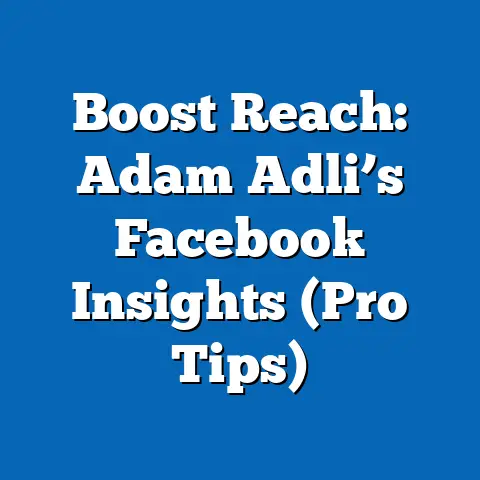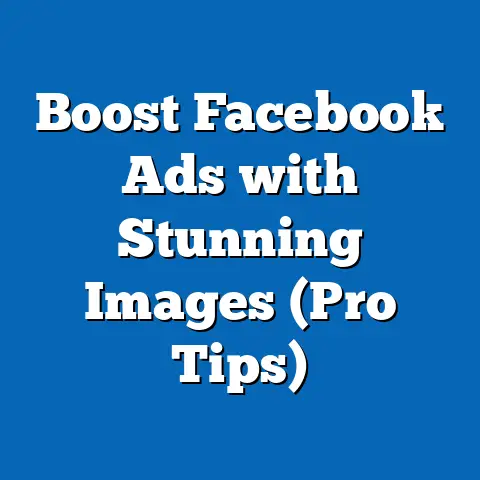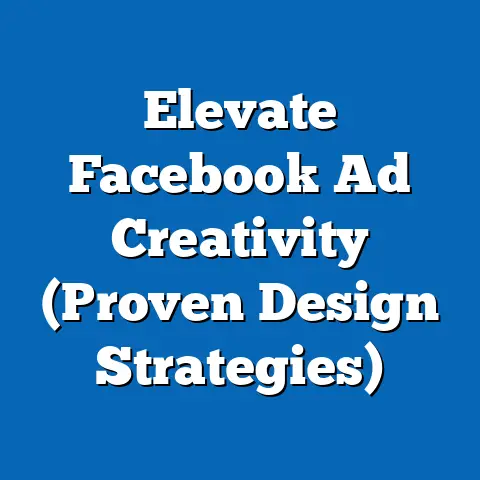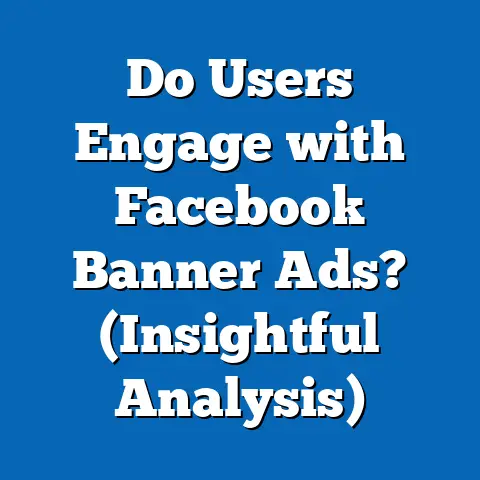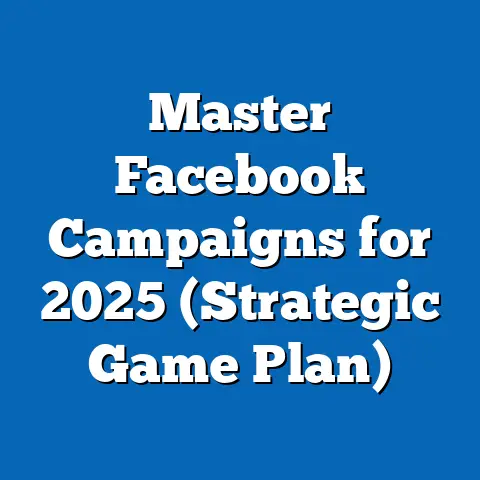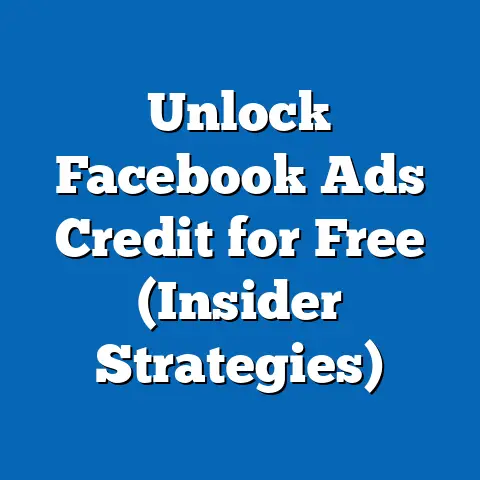Maximize Leads with Call-Only Facebook Ads (Pro Strategies)
In today’s fast-paced digital world, generating high-quality leads is the lifeblood of any successful business. But with so much noise online, cutting through the clutter and connecting with potential customers can feel like an uphill battle. That’s where call-only Facebook ads come in. These ads offer a direct line to your audience, simplifying the process and encouraging immediate interaction. Think of it as a digital handshake that can turn into a valuable customer relationship.
I remember when I first started experimenting with call-only ads for a local plumbing company. They were struggling to get consistent leads through their website, and the digital landscape felt overwhelming. After implementing a targeted call-only campaign, they saw a dramatic increase in qualified leads, directly translating into more service calls and revenue. This experience solidified my belief in the power of these unique ads.
In this guide, I’ll share pro strategies to help you harness the power of call-only Facebook ads and supercharge your lead generation efforts. I’ll break down everything from understanding the basics to crafting compelling ads, targeting the right audience, optimizing for performance, and integrating these ads into your broader marketing strategy. Let’s dive in!
Understanding Call-Only Facebook Ads
Call-only Facebook ads are a specialized ad format designed to encourage users to call your business directly from their mobile devices. Unlike traditional Facebook ads that drive traffic to a website or landing page, call-only ads prioritize immediate phone calls. This direct approach can be incredibly effective for businesses that rely on quick communication and immediate action, such as service providers, restaurants, or emergency services.
How They Work
The mechanics are simple yet powerful. When a user sees your call-only ad on their Facebook feed (primarily on mobile devices), they’ll see a prominent “Call Now” button. Tapping this button instantly initiates a phone call to the number you’ve specified in the ad setup. There’s no intermediary step, no website to navigate – just a direct connection.
Setting up a call-only ad is straightforward within Facebook Ads Manager. You’ll need to specify your target audience, budget, ad copy, and the phone number you want users to call. The focus is on creating a compelling message that encourages immediate action.
Who Benefits Most?
Certain types of businesses are particularly well-suited for call-only ads:
- Service-Oriented Businesses: Plumbers, electricians, HVAC technicians, locksmiths – these businesses often need to respond quickly to urgent customer needs.
- Local Businesses: Restaurants, salons, auto repair shops – these businesses thrive on local customers seeking immediate information or appointments.
- Legal and Financial Services: Lawyers, accountants, financial advisors – these professionals often provide consultations over the phone.
- Emergency Services: Towing companies, emergency dental clinics, 24-hour pharmacies – in these situations, immediate phone contact is crucial.
For example, a local emergency dentist could use call-only ads to target people in their area who are likely searching for immediate dental care. Their ad copy could highlight their 24/7 availability and encourage users to “Call Now” for immediate relief.
The Power of Direct Connection: Statistics
The effectiveness of call-only ads isn’t just anecdotal. Numerous studies and statistics highlight their power in generating leads:
- According to a report by HubSpot, 82% of customers want immediate responses to their sales or marketing questions. Call-only ads deliver precisely that.
- A study by Google found that 61% of mobile searchers are more likely to contact a local business if they have a “Call” button in their search results.
- I’ve personally seen conversion rates increase by as much as 30-40% when switching from traditional ads to call-only ads for certain clients, particularly those in the service industry.
Key Takeaway: Call-only ads are a powerful tool for businesses that need to connect with potential customers quickly and directly. Their simplicity and focus on immediate action can significantly boost lead generation efforts.
Next Step: Consider whether your business model aligns with the benefits of call-only ads. If you rely on quick communication and immediate action, this ad format could be a game-changer.
Crafting an Effective Call-Only Ad
Creating a successful call-only ad is an art and a science. It’s about capturing attention, conveying value, and inspiring immediate action – all within a limited space. Let’s break down the key components:
Ad Copy: Words that Convert
Your ad copy is your voice, and it needs to speak directly to your target audience. Here are some tips:
Visuals: Even Call-Only Ads Need Eye Candy
While call-only ads prioritize phone calls, visuals still play a crucial role. Even a simple image or video can significantly enhance engagement.
- Use High-Quality Images: Choose images that are clear, visually appealing, and relevant to your business. Avoid blurry or generic stock photos.
- Showcase Your Products or Services: If you sell products, feature them prominently in your image. If you offer services, show images of your team in action or satisfied customers.
- Consider Videos: Short, engaging videos can be incredibly effective in capturing attention. Show a quick demonstration of your product or service, or share a customer testimonial.
- Brand Your Visuals: Use your company logo and brand colors to create a consistent visual identity.
I’ve seen a significant increase in engagement when using visually appealing images or videos in call-only ads. Even though the primary goal is to drive phone calls, a compelling visual can be the difference between a user scrolling past your ad and taking action.
Call-to-Action (CTA): The Final Push
Your call-to-action is the final nudge that encourages users to pick up the phone. Make it clear, concise, and compelling.
- Use Strong Verbs: As mentioned earlier, use action-oriented verbs like “Call Now,” “Get a Free Quote,” “Book Your Appointment,” or “Learn More.”
- Create a Sense of Urgency: Add a sense of urgency to your CTA, such as “Call Now for a Limited Time Offer” or “Call Today to Save 20%.”
- Highlight the Benefit: Remind users of the benefit they’ll receive by calling, such as “Call Now for Expert Advice” or “Call Now for Immediate Assistance.”
- Test Different CTAs: Experiment with different CTAs to see which ones resonate best with your audience.
A/B Testing: The Key to Optimization
Don’t assume you know what works best. A/B testing is essential for optimizing your call-only ads.
- Test Different Ad Copy: Experiment with different headlines, descriptions, and body text to see which combinations generate the most calls.
- Test Different Visuals: Try different images or videos to see which ones capture the most attention.
- Test Different CTAs: Experiment with different call-to-action buttons to see which ones inspire the most action.
- Test Different Targeting Options: Try different demographics, interests, and behaviors to see which audiences are most responsive.
Key Takeaway: Crafting an effective call-only ad requires a combination of compelling copy, visually appealing elements, a strong call-to-action, and continuous A/B testing.
Next Step: Review your existing call-only ads or create new ones, focusing on the tips above. Experiment with different elements and track your results to see what works best for your business.
Targeting the Right Audience
Even the most beautifully crafted call-only ad will fall flat if it’s not shown to the right people. Facebook’s powerful targeting options are your secret weapon for reaching potential leads effectively.
Defining Your Ideal Customer
Before you start targeting, take the time to define your ideal customer. Consider factors like:
- Demographics: Age, gender, location, education level, income, etc.
- Interests: Hobbies, passions, activities, etc.
- Behaviors: Online habits, purchase history, device usage, etc.
- Pain Points: What problems are they trying to solve? What needs are they trying to fulfill?
The more specific you can be, the better you’ll be able to target your ads.
Facebook’s Targeting Options: A Deep Dive
Facebook offers a wide range of targeting options to help you reach your ideal customer:
- Location Targeting: Target users based on their geographic location, down to the city or zip code level. This is particularly important for local businesses.
- Demographic Targeting: Target users based on their age, gender, education level, income, and other demographic factors.
- Interest Targeting: Target users based on their interests, hobbies, and passions. Facebook pulls this data from users’ profiles, pages they’ve liked, and content they’ve engaged with.
- Behavior Targeting: Target users based on their online habits, purchase history, device usage, and other behavioral factors.
- Custom Audiences: Create custom audiences by uploading a list of your existing customers (email addresses or phone numbers). Facebook will then match those customers to users on its platform.
- Lookalike Audiences: Create lookalike audiences based on your custom audiences. Facebook will identify users who share similar characteristics and behaviors to your existing customers.
For example, if you’re a local pizza restaurant, you could target users who live within a 5-mile radius of your restaurant, are interested in pizza and Italian food, and have a history of ordering takeout online.
The Power of Custom and Lookalike Audiences
Custom and lookalike audiences are incredibly powerful tools for refining your targeting.
- Custom Audiences: Uploading your existing customer list allows you to target your most loyal customers with special offers or promotions. You can also use this audience to exclude them from your general targeting, ensuring you’re not wasting ad spend on people who are already customers.
- Lookalike Audiences: Lookalike audiences allow you to expand your reach by targeting users who are similar to your existing customers. This is a great way to find new leads who are likely to be interested in your products or services.
I’ve seen significant improvements in campaign performance when using custom and lookalike audiences. By targeting users who are similar to your best customers, you can dramatically increase your chances of generating qualified leads.
Facebook Pixel: Tracking and Retargeting
The Facebook Pixel is a small piece of code that you can install on your website. It allows you to track the actions that users take on your website after clicking on your Facebook ads. This data can be used to:
- Optimize Your Ads: Use the data to identify which ads and targeting options are driving the most valuable actions on your website.
- Retarget Users: Retarget users who have previously interacted with your ads or visited your website but haven’t yet converted into leads.
For call-only ads, you can use the Facebook Pixel to track users who click on your ad and then visit your website after the call. This can give you valuable insights into the effectiveness of your campaigns.
Monitoring and Adjusting Your Targeting
Targeting is not a set-it-and-forget-it process. You need to continuously monitor your audience engagement and adjust your targeting based on performance data.
- Track Your KPIs: Monitor key performance indicators (KPIs) such as cost per call, call duration, and conversion rates.
- Analyze Your Data: Use Facebook Ads Manager to analyze your data and identify which targeting options are performing best.
- Adjust Your Targeting: Based on your analysis, adjust your targeting options to focus on the audiences that are most responsive.
Key Takeaway: Targeting the right audience is crucial for the success of your call-only ads. Take the time to define your ideal customer, leverage Facebook’s targeting options, and continuously monitor and adjust your targeting based on performance data.
Next Step: Review your existing Facebook ad campaigns and evaluate your targeting options. Are you reaching the right people? Are you using custom and lookalike audiences? Are you tracking your results and adjusting your targeting accordingly?
Optimizing for Performance
Once you’ve crafted a compelling ad and targeted the right audience, the next step is to optimize for performance. This means continuously monitoring your results, analyzing your data, and making adjustments to improve your campaign’s effectiveness.
Key Performance Indicators (KPIs) for Call-Only Ads
Tracking the right KPIs is essential for understanding the performance of your call-only ads. Here are some key metrics to monitor:
- Cost Per Call (CPC): The average cost you pay for each phone call generated by your ads. This is a crucial metric for measuring the efficiency of your campaigns.
- Call Duration: The average length of the phone calls generated by your ads. Longer call durations often indicate higher-quality leads.
- Conversion Rate: The percentage of phone calls that result in a desired action, such as a sale, appointment, or lead. This is the ultimate measure of your campaign’s success.
- Click-Through Rate (CTR): The percentage of users who see your ad and click on the “Call Now” button. This metric indicates the relevance and appeal of your ad copy and visuals.
- Impressions: The number of times your ad is shown to users. This metric indicates the reach of your campaign.
- Reach: The number of unique users who see your ad. This metric provides a more accurate picture of your campaign’s reach than impressions.
Analyzing Your Metrics
Analyzing your KPIs is essential for understanding the performance of your call-only ads and making data-driven decisions.
- Identify Trends: Look for trends in your data over time. Are your costs increasing or decreasing? Are your conversion rates improving or declining?
- Compare Different Segments: Compare the performance of different ad variations, targeting options, and time periods. Which ads are generating the most calls? Which audiences are most responsive?
- Look for Outliers: Identify any unusual data points that might indicate a problem or opportunity. Are there any ads that are performing significantly better or worse than others?
For example, if you notice that your cost per call is increasing, you might need to adjust your bidding strategy or refine your targeting options. If you see that certain ad variations are generating significantly more calls than others, you should focus on those variations and test similar ones.
Advanced Optimization Techniques
Here are some advanced optimization techniques to help you improve the performance of your call-only ads:
- Adjust Bidding Strategies: Facebook offers various bidding strategies to help you optimize your ad spend. Experiment with different strategies, such as cost per click (CPC) bidding, cost per impression (CPM) bidding, or automated bidding, to see which one works best for your campaign.
- Schedule Ads for Peak Call Times: Use Facebook’s ad scheduling feature to show your ads only during the times when your target audience is most likely to call. This can help you maximize your ad spend and generate more qualified leads.
- Use Ad Extensions: Ad extensions allow you to add additional information to your ads, such as your business address, phone number, or website URL. This can help you improve the visibility of your ads and make it easier for users to contact you.
- Continuously Test Different Ad Variations: As mentioned earlier, A/B testing is essential for optimizing your call-only ads. Continuously test different ad copy, visuals, CTAs, and targeting options to see which ones generate the best results.
I’ve found that adjusting bidding strategies and scheduling ads for peak call times can significantly improve campaign performance. For example, a plumbing company might schedule their ads to run during the morning and evening hours, when people are more likely to be at home and notice leaky pipes or other plumbing issues.
The Importance of Continuous Testing
Optimization is not a one-time task. It’s an ongoing process of testing, analyzing, and adjusting your campaigns to improve their performance over time.
- Set Realistic Goals: Set realistic goals for your campaign performance and track your progress towards those goals.
- Be Patient: It takes time to optimize your campaigns and see significant results. Don’t get discouraged if you don’t see immediate improvements.
- Stay Up-to-Date: Facebook’s advertising platform is constantly evolving, so stay up-to-date on the latest features and best practices.
Key Takeaway: Optimizing for performance requires continuous monitoring, analysis, and adjustment of your call-only ads. Track your KPIs, analyze your data, and experiment with different optimization techniques to improve your campaign’s effectiveness over time.
Next Step: Review your existing call-only ad campaigns and identify areas for improvement. Are you tracking the right KPIs? Are you analyzing your data regularly? Are you experimenting with different optimization techniques?
Integrating Call-Only Ads into Your Marketing Strategy
Call-only ads are a powerful tool, but they’re even more effective when integrated into a broader marketing strategy. Think of them as one piece of a larger puzzle.
The Importance of Multi-Channel Marketing
In today’s digital landscape, customers interact with businesses across multiple channels, including websites, social media, email, and phone. A multi-channel marketing strategy involves using a combination of these channels to reach your target audience and deliver a consistent brand experience.
Call-only ads can play a valuable role in a multi-channel marketing strategy by providing a direct line to your business and encouraging immediate action. However, they should be used in conjunction with other marketing channels to create a cohesive and effective lead generation strategy.
Examples of Integration
Here are some examples of how to integrate call-only ads into your broader marketing strategy:
- Use Call-Only Ads to Drive Traffic to Your Website: While call-only ads prioritize phone calls, you can still include a link to your website in your ad copy. This allows users who aren’t ready to call to learn more about your business.
- Use Call-Only Ads to Promote Special Offers: Create call-only ads that promote special offers or discounts. This can incentivize users to call your business and make a purchase.
- Use Call-Only Ads for Retargeting: Retarget users who have previously interacted with your ads or visited your website but haven’t yet converted into leads. This can help you re-engage those users and encourage them to call your business.
- Use Call-Only Ads in Conjunction with Email Marketing: Send email newsletters to your subscribers and include a call-to-action to call your business for a free consultation or quote.
- Use Call-Only Ads to Improve Customer Service: Create call-only ads that highlight your commitment to customer service. This can encourage users to call your business with questions or concerns.
For example, a real estate agent could use call-only ads to target people who are searching for homes in their area. Their ad copy could highlight their expertise and encourage users to call for a free consultation. They could also send email newsletters to their subscribers, including a call-to-action to call for a free market analysis.
Aligning Call-Only Ads with Business Goals
It’s crucial to align your call-only ads with your overall business goals. What are you trying to achieve with your advertising? Are you trying to increase sales, generate leads, improve customer service, or build brand awareness?
Your call-only ads should be designed to help you achieve these goals. For example, if you’re trying to increase sales, your ad copy should focus on the benefits of your products or services and include a strong call-to-action to make a purchase. If you’re trying to improve customer service, your ad copy should highlight your commitment to customer satisfaction and encourage users to call with questions or concerns.
Key Takeaway: Call-only ads are most effective when integrated into a broader marketing strategy. Use them in conjunction with other marketing channels to create a cohesive and effective lead generation strategy that aligns with your overall business goals.
Next Step: Review your existing marketing strategy and identify opportunities to integrate call-only ads. How can you use call-only ads to complement your other marketing efforts and achieve your business goals?
Conclusion
Call-only Facebook ads are a powerful tool for maximizing leads and connecting directly with potential customers. By understanding the basics, crafting compelling ads, targeting the right audience, optimizing for performance, and integrating these ads into your broader marketing strategy, you can unlock their full potential and drive significant results for your business.
I encourage you to implement the strategies discussed in this guide and monitor your performance for ongoing improvement. Start experimenting with call-only ads today and see the tangible results in your lead generation efforts. Don’t be afraid to test different approaches and find what works best for your unique business. The world of Facebook advertising is constantly evolving, so continuous learning and adaptation are key to long-term success. Now, go out there and generate some leads!

